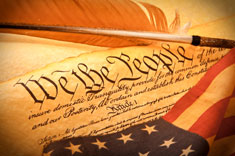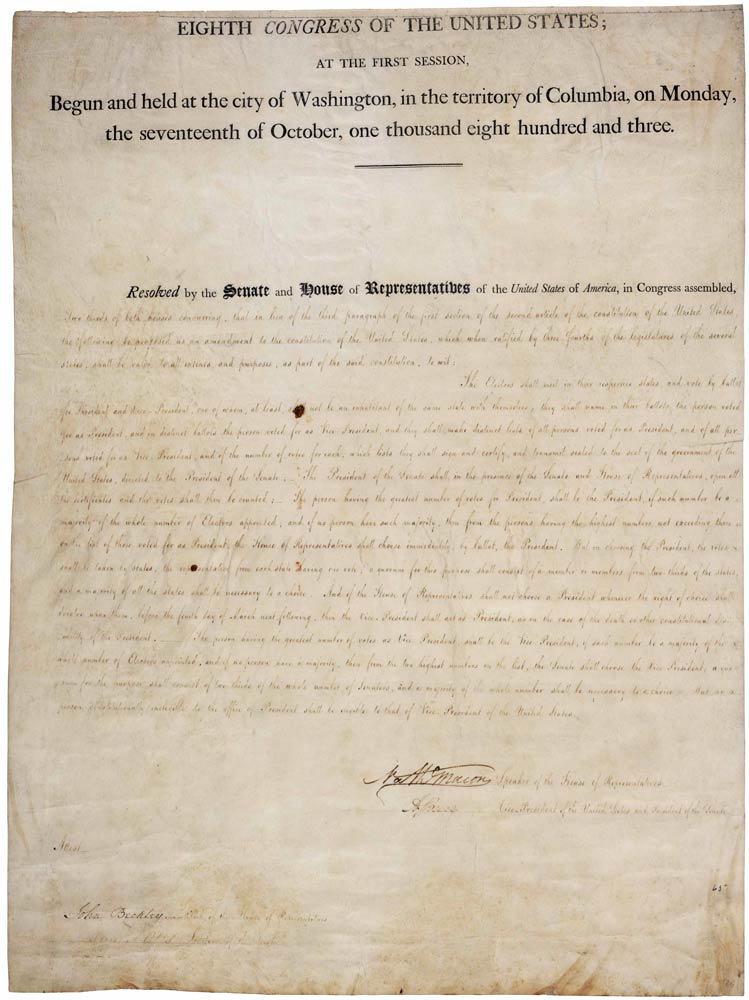| United States Constitution | |
|---|---|
 |
|
| The U.S. Constitution | |
| Preamble | |
| Articles of the Constitution | |
| I ‣ II ‣ III ‣ IV ‣ V ‣ VI ‣ VII | |
| Amendments to the Constitution | |
| Bill of Rights | |
| I ‣ II ‣ III ‣ IV ‣ V ‣ VI ‣ VII ‣ VIII ‣ IX ‣ X | |
| Additional Amendments | |
| XI ‣ XII ‣ XIII ‣ XIV ‣ XV ‣ XVI ‣ XVII ‣ XVIII ‣ XIX ‣ XX ‣ XXI ‣ XXII ‣ XXIII ‣ XXIV ‣ XXV ‣ XXVI ‣ XXVII | |
| View the Full Text | |
| Original Constitution | |
| Bill of Rights | |
| Additional Amendments |
The Twelfth Amendment to the United States Constitution was ratified on June 15, 1804 as a result of the two previous disastrous elections of 1796 and 1800. This amendment addressed a problem that existed in the original language of the Constitution regarding protocol for electing the President and Vice-president. It also revised the procedures by which the Electoral College operated.
Text
The Electors shall meet in their respective states, and vote by ballot for President and Vice-President, one of whom, at least, shall not be an inhabitant of the same state with themselves; they shall name in their ballots the person voted for as President, and in distinct ballots the person voted for as Vice-President, and they shall make distinct lists of all persons voted for as President, and all persons voted for as Vice-President and of the number of votes for each, which lists they shall sign and certify, and transmit sealed to the seat of the government of the United States, directed to the President of the Senate.
The President of the Senate shall, in the presence of the Senate and House of Representatives, open all the certificates and the votes shall then be counted.
The person having the greatest Number of votes for President, shall be the President, if such number be a majority of the whole number of Electors appointed; and if no person have such majority, then from the persons having the highest numbers not exceeding three on the list of those voted for as President, the House of Representatives shall choose immediately, by ballot, the President. But in choosing the President, the votes shall be taken by states, the representation from each state having one vote; a quorum for this purpose shall consist of a member or members from two-thirds of the states, and a majority of all the states shall be necessary to a choice. And if the House of Representatives shall not choose a President whenever the right of choice shall devolve upon them, before the fourth day of March next following, then the Vice-President shall act as President, as in the case of the death or other constitutional disability of the President.[1]
The person having the greatest number of votes as Vice-President, shall be the Vice-President, if such number be a majority of the whole number of Electors appointed, and if no person have a majority, then from the two highest numbers on the list, the Senate shall choose the Vice-President; a quorum for the purpose shall consist of two-thirds of the whole number of Senators, and a majority of the whole number shall be necessary to a choice. But no person constitutionally ineligible to the office of President shall be eligible to that of Vice-President of the United States.
Background
 As is often the case, legalities, rules, regulations, and methodologies that make sense in documentation form often reveal gaping holes when placed into practice. Such was the case with the electoral system in the United States prior to the 12th Amendment. A system in which the Electoral College tallied the votes and the person with the most votes became President, while the second runner-up became Vice-president, seemed to make sense. However, as evidenced in the election of 1796, this was glaringly wrong.
As is often the case, legalities, rules, regulations, and methodologies that make sense in documentation form often reveal gaping holes when placed into practice. Such was the case with the electoral system in the United States prior to the 12th Amendment. A system in which the Electoral College tallied the votes and the person with the most votes became President, while the second runner-up became Vice-president, seemed to make sense. However, as evidenced in the election of 1796, this was glaringly wrong.
This system resulted in an incompatibility between the newly elected President and Vice-president, due to their former opposition to each other before the election. In the election of 1796, the two opponents for the presidency, John Adams of the Federalist Party and Thomas Jefferson of the Democratic-Republican Party, won the election. John Adams received 71 electoral votes, and Thomas Jefferson received 68 electoral votes. Under the existing Constitution, John Adams was thus President and Thomas Jefferson Vice-President. It would be comparable to Mitt Romney being Vice President to President Obama.
As unworkable as this scenario was, it was about to worsen. The election of 1800 was one in which President Adams found himself running against his own Vice-president, Thomas Jefferson. In an effort to dispel the chaos, each political party nominated two persons, each of which would run for the specific office of President and Vice-president. The practice of a presidential candidate choosing a running mate had not yet come into being.
This new system resulted in John Adams and Charles Pinckney running on the Federalist ticket, with Thomas Jefferson and Aaron Burr running on the Democrat-Republican ticket. The team of Jefferson and Burr won the election with a total electoral vote of 73. While it was understood that Jefferson and Burr were running mates, no distinction had been made as to who was running for president, and who for vice-president. And, since neither Jefferson nor Burr captured a majority, Congress was given the task of deciding who would be President. This had the effect of pitting Burr and Jefferson, running mates, against each other. After more voting, and a lot of bargaining, Jefferson was named President of the United States.
After two disastrous elections, the need for a constitutional amendment was obvious.
Ratification
Just a few short months before the next election in 1804, the 12th Amendment to the Constitution was ratified. Its provisions include:
• Electors, who formerly just placed two votes for president, would now cast separate and distinct votes for a president, and for a vice-president; furthermore, at least one of the persons voted for must not reside in the same state as that of the elector.
• Persons ineligible to serve as President would not be eligible for the Vice-Presidency.
• When an election yields no win by majority of electoral votes, the House of Representatives conducts an election, based upon the three who received the highest number of votes.
• In a like fashion, the Senate chooses the Vice-President, except the choices are between the two with the most number of electoral votes; or, if several persons are tied for this vote, the Senate may choose to consider all of them in its voting procedure.
The Twelfth Amendment also set forth the timelines in which deadlocks must be broken in order to not allow any of these offices to go unfilled for a prolonged period of time.
In Summary
Although considered controversial by some, the Twelfth Amendment has endured through the ages since its ratification. It is still in practice today, with distinct votes being cast by the Electoral College for President or Vice-president. Although no specific party affiliation is recognized in the verbiage of the Amendment, the implication is present.
The controversy arises from the structure of the overall voting. Since the advent of the Constitution, many have voiced concern and opposition over the system of using the Electoral College for presidential elections, rather than the popular vote.